3-Day Nagoya, Japan Travel Itinerary

Introduction:
Nagoya, located in the Chubu region of central Japan, is Japan’s fourth-largest city and a fascinating blend of historical heritage, industrial innovation, and modern city life. This city is known for its role in the automotive industry, being home to Toyota’s headquarters. But beyond its industrial fame, Nagoya also offers travelers a mix of cultural sites, shopping streets, traditional cuisine, and family-friendly attractions. This 3-day itinerary is designed for travelers who want to dive into Nagoya’s rich samurai history, discover its vibrant shopping districts, and explore unique museums and parks.
Places to Visit:
- Nagoya Castle: This historical castle is a symbol of the city, built in 1612, and is known for its golden shachihoko ornaments and beautiful surrounding gardens.
- Atsuta Shrine: One of Japan’s most important Shinto shrines, believed to house the sacred sword Kusanagi-no-Tsurugi, one of the Imperial Regalia of Japan.
- Osu Shopping Street: A vibrant shopping district with a mix of vintage shops, modern fashion, electronics, and delicious street food.
- Toyota Commemorative Museum of Industry and Technology: A museum showcasing Toyota’s transition from textile machinery to automobile manufacturing.
- Nagoya City Science Museum: Home to one of the world’s largest planetariums, this museum features interactive exhibits and is ideal for both kids and adults.
- SCMAGLEV and Railway Park: A museum operated by JR Central, showcasing the history and future of high-speed rail, including maglev train models.
- Higashiyama Zoo and Botanical Gardens: A popular family destination offering a large zoo, botanical gardens, and an observation tower.
- Tokugawa Art Museum: This museum exhibits the treasures of the powerful Tokugawa family, including samurai armor, swords, and scrolls.
- Sakae District: A central area for shopping and nightlife, known for its modern architecture and the iconic Nagoya TV Tower.
- Port of Nagoya Public Aquarium: One of Japan’s best aquariums, featuring beluga whales, dolphins, and penguins in spacious, naturalistic tanks.

Sample Itinerary:
Day 1: Historic and Cultural Discovery
- 9:00 AM – Nagoya Castle: Start the morning at Nagoya Castle. Spend 1.5 hours exploring the grounds, reconstructed palace, and historical exhibits.
- 11:00 AM – Atsuta Shrine: Travel by subway for 20 minutes to Atsuta Shrine. Spend 45 minutes walking through its serene grounds and treasure hall.
- 12:30 PM – Lunch in Osu: Head to Osu Shopping Street (15-minute subway ride). Try hitsumabushi (grilled eel rice) at a local restaurant.
- 2:00 PM – Explore Osu Shopping Street: Spend 1.5–2 hours browsing unique shops, anime stores, and eating local snacks like taiyaki and karaage.
- 5:00 PM – Return to hotel/rest and dinner near Sakae.
Day 2: Museums and Modern Attractions
- 9:00 AM – Toyota Commemorative Museum: Arrive early to explore Toyota’s history and future tech. Allocate 1.5 hours.
- 11:00 AM – Nagoya City Science Museum: A 10-minute taxi ride or subway. Spend 2 hours experiencing hands-on science exhibits and the planetarium.
- 1:30 PM – Lunch in Fushimi: Eat at a nearby restaurant specializing in miso katsu (Nagoya-style pork cutlet).
- 3:00 PM – SCMAGLEV and Railway Park: Take a 20-minute train ride to the museum. Spend 1.5 hours checking out trains and simulators.
- 6:00 PM – Dinner and explore Sakae’s nightlife.

Day 3: Nature, Art, and Relaxation
- 9:00 AM – Higashiyama Zoo and Botanical Gardens: Spend the morning at this vast site. Allocate about 2.5 hours, including a visit to the Sky Tower.
- 12:00 PM – Lunch at Higashiyama Park Café.
- 1:30 PM – Tokugawa Art Museum: Travel 20 minutes by subway. Spend 1 hour admiring samurai artifacts and Edo-period treasures.
- 3:00 PM – Nagoya Port Aquarium: Take a 30-minute train to the port area. Spend 1.5–2 hours enjoying marine shows and aquatic life.
- 6:00 PM – Enjoy dinner by the port and end your trip with a seaside stroll.
See Itinerary Map (Includes Places to Visit and Accommodations)
Best Time To Go:
The best time to visit Nagoya is during spring (March to May) and autumn (September to November). Spring offers pleasant temperatures (around 13°C to 23°C) and beautiful cherry blossoms, especially in parks around the castle. Autumn provides mild weather and colorful foliage in city gardens. Summer (June to August) can be hot and humid, while winter (December to February) is cold but manageable, averaging 1°C to 10°C, and still a good time for indoor attractions.
Activities To Do:
- Experience Nagoya’s Specialty Foods: Nagoya is famous for its regional cuisine, like miso katsu, hitsumabushi, and tebasaki (chicken wings). These dishes reflect the city’s bold and savory culinary style.
- Visit a Samurai-Era Museum: The Tokugawa Art Museum houses historical artifacts from the shogunate period, perfect for history buffs interested in samurai culture.
- Ride a Maglev Simulator: At the SCMAGLEV and Railway Park, you can try train-driving simulators and see futuristic train technology.
- Watch Dolphin Shows: The Port Of Nagoya Public Aquarium offers entertaining dolphin and beluga whale shows in a massive aquatic arena.
- Enjoy Night Views from Nagoya TV Tower: Located in Sakae, this tower provides romantic views of the illuminated city and is a great photo opportunity.

Accommodations:
- Nagoya Marriott Associa Hotel: A luxurious hotel located above Nagoya Station, offering panoramic views and direct Shinkansen access.

- Daiwa Roynet Hotel Nagoya Taiko-dori Side: A mid-range hotel with clean, modern rooms just steps from the train station.

- Meitetsu Grand Hotel: Conveniently located and ideal for travelers who want easy airport connections via Meitetsu Rail.

- Nagoya JR Gate Tower Hotel: Situated within the JR Gate Tower complex, offering upscale accommodation and shopping access.

- The Royal Park Canvas Nagoya: A boutique-style hotel with a chic design, located close to Fushimi and Sakae districts.

Transportation Options:
- Subway: Nagoya has an efficient subway system with 6 lines that connect major attractions. It’s the best way to get around the city.
- JR and Meitetsu Trains: These lines are perfect for getting to and from Nagoya Station, the airport, and other cities like Kyoto or Tokyo.
- Buses: City buses are available but can be confusing for first-time visitors. Use mainly for places not covered by subway.
- Taxis: Taxis are available and reliable but more expensive. Ideal for short trips or late-night travel.
- Walking: Many attractions within central areas like Sakae and Osu are walkable, making strolling an easy way to explore.
Tips:
- Purchase a One-Day Subway Pass for unlimited subway rides, especially useful for days with multiple stops.
- Book Nagoya Castle and aquarium tickets online to skip the lines, especially during weekends or cherry blossom season.
- Try local delicacies early in your trip, as many restaurants close early or get crowded.
- Pack comfortable walking shoes, as most sightseeing involves a lot of walking between attractions.
-
Carry a prepaid IC card (like Manaca) for hassle-free rides on buses and trains.
Nagoya is a destination that beautifully combines tradition, technology, and vibrant urban culture. With its well-preserved castles, cutting-edge museums, delicious local food, and diverse attractions, Nagoya offers something for every traveler. Whether you’re diving into samurai history, watching a dolphin show, or shopping in lively streets, this 3-day itinerary ensures a fulfilling and well-paced journey through one of Japan’s most underrated cities.



